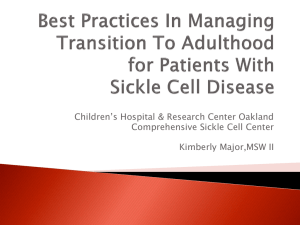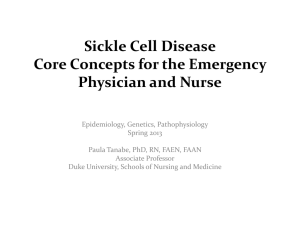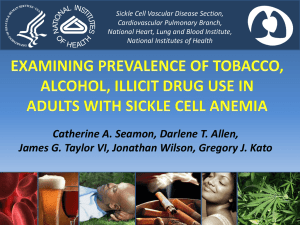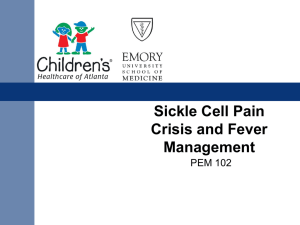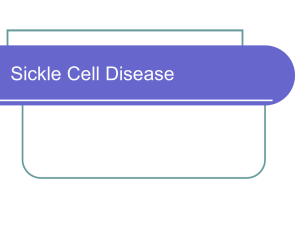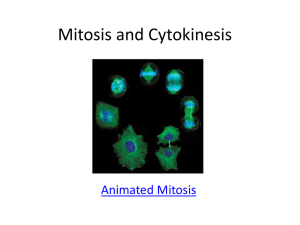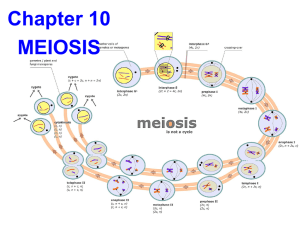chromosomes - Life Science Academy
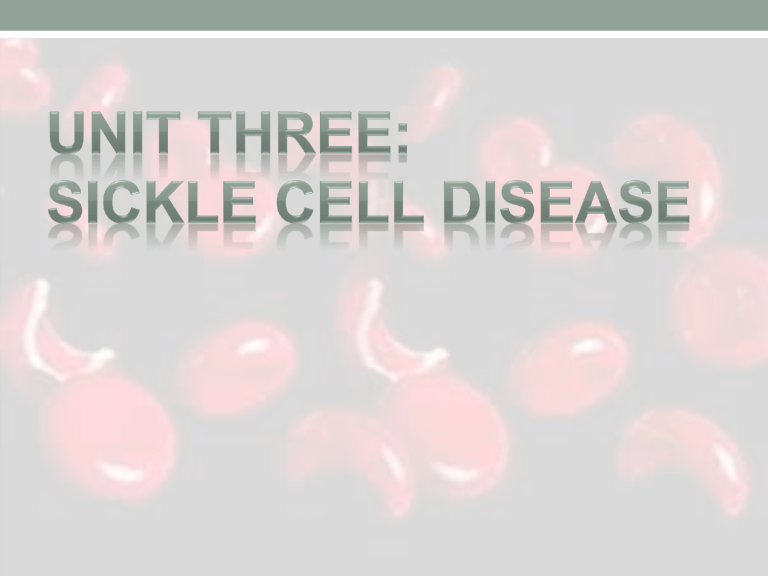
3.1 Essential Questions & Key Terms
3.
4.
5.
1.
2.
What is sickle cell disease?
Why does the sickling of red blood cells cause health problems?
What is sickle cell anemia?
How is anemia diagnosed?
How does sickle cell disease affect daily life?
Key Terms
Anemia
Blood Plasma
Erythrocytes (Red Blood Cells)
Hematocrit
Leukocytes (White Blood Cells)
Sickle Cell Disease
Thrombocytes (Platelets)
Sickle Cell Disease
• Disease passed down through families
• Caused by an abnormal type of hemoglobin called hemoglobin S
• Affects red blood cells
• Red blood cells (normally shaped like a disc) form an abnormal sickle/crescent shape
Hemoglobin
• Protein
• Primary component of red blood cells
• Composed of four sub-units
• Each carries one oxygen molecule
• People with sickle cell have abnormal hemoglobin
Sickle Cell Disease
• Sickled Red Blood Cells
1.
2.
Deliver less oxygen
Get stuck more easily in small blood vessels
3.
Fragile- break into pieces that can interrupt healthy blood flow
•
•
Decrease the amount of oxygen flowing to body tissues even more
…feedback loop?
The Affects of SCD
• Millions of people throughout the world- major public health concern
• 3% of people with SCD die annually- sudden death
• More prone to blood clots
• Heart attacks
• Strokes
• Pulmonary embolisms
• Increased susceptibility to bacterial and viral infections.
Anemia
• Blood is deficient in red blood cells, in hemoglobin, or in total volume
• SCD often causes anemia
• Referred to as Sickle
Cell Anemia
•
Activity 3.1.1: Blood Detectives
Anna Garcia’s autopsy report shows she had SCD
• You will learn the components and function of blood in order to better understand SCD and it’s impact on the body
1.
2.
3.
You will examine Anna’s blood with a microscope
You will design an experiment to see how cell shape impacts movement
You will complete a hematocrit blood test to determine whether
Anna’s SCD was causing other related health problems
3.1.2 Sickle Cell Diaries: @ Home
• Almost every patient with SCD experiences painful episodes called crises
• The crises can be severe enough to require a hospital stay
• Anna’s doctor asked her to keep a diary documenting all of her crises
• In this activity you are going to investigate what life is like living with SCD…
3.1.2 Sickle Cell Diaries: @ Home
• All docs are online
• 2 Tables
• One before you collaborate
• One after
• Collaborate online
• Over the phone
• 2 Journal Entries
• Pick any patient
• Pick one career journal
• Due Friday January 17th
Blood Plasma
• The pale yellow fluid portion of whole blood
Erythrocytes (Red Blood Cells)
• Hemoglobin-containing cells that carry oxygen to tissues and take carbon dioxide back to your lungs to be exhaled
• Responsible for the red color of vertebrate blood
Leukocytes (White Blood Cells)
• Colorless blood cells that lack hemoglobin and contain a nucleus: lymphocytes, monocytes, neutrophils, eosinophils, and basophils
• Destroy bacteria
• Produce antibodies against bacteria and viruses
• Fight malignant diseases
Thrombocytes (Platelets)
• A minute colorless anucleate (no nucleus) disk-like body of mammalian blood
• Main function is to interact with clotting proteins to stop or prevent bleeding
Hematocrit
• The percent of the volume of whole blood that is composed of red blood cells
• Determined by separation of red blood cells from the plasma usually by centrifugation
Hematocrit Results
Anna’s hematocrit is approximately
30% red blood cell volume.
Anything less than 35% for a female is considered a low hematocrit
3.1 The Disease: Review
1.
2.
3.
4.
5.
What is sickle cell disease?
Why does the sickling of red blood cells cause health problems?
What is sickle cell anemia?
How is anemia diagnosed?
How does sickle cell disease affect daily life?
Key Terms
Anemia
Blood Plasma
Erythrocytes (Red Blood Cells)
Hematocrit
Leukocytes (White Blood Cells)
Sickle Cell Disease
Thrombocytes (Platelets)
3.2 It’s in the Genes: Essential Questions
& Key Terms
1.
2.
3.
4.
5.
6.
7.
8.
9.
What is the DNA code?
What is the connection between genes and proteins?
How are proteins produced in a cell?
How does the sequence of nucleotides in DNA determine the sequence of amino acids in a protein?
What is a mutation?
What determines the shape of a protein?
Is the shape of a protein affected by its surrounding environment?
How does a change in the DNA code affect the shape of a protein?
Can changing just one nucleotide in a gene change the shape of a protein?
Key Terms
Amino Acid
Anticodon
Codon
Hydrophilic
Hydrophobic
Messenger RNA (mRNA)
Mutation
Nucleotide
Protein
Protein Synthesis
Ribonucleic Acid (RNA)
Ribosome
Transcription
Transfer RNA (tRNA)
Translation
Proteins
• What we know…
• DNA codes for proteins
• Proteins produced all our genetic traits
• Responsible for just about everything our bodies do
• Amazingly…
• All the proteins we need are manufactured based on a code of four letters: A,T, C and G
• The arrangement of these nucleotides dictates everything we are genetically and runs our whole bodies, because they dictate what proteins our bodies produce
3.2.1 Protein Synthesis
1.
2.
3.
4.
5.
6.
7.
The information on DNA is copied onto an mRNA strand
As, Cs, Gs and Us (in place of Ts) mRNA leaves the nucleus and moves into the cytoplasm
A ribosome attaches to the mRNA tRNA molecules bring amino acids (there are 20) into the ribosome
The amino acid sequences match up with mRNA sequences- 3 at a time (codons)
The ribosome assembles the amino acids into the specific protein originally coded for by the gene on the
DNA
Transcription & Translation
WATCH VIDEO
From DNA to mRNA to Amino Acid:
A= U
A= U
C= G
G= C
A= U
T= A
A= U
C= G
C= G
Structure of Proteins
• Polymers of amino acids
• Joined by peptide bonds
Activity 3.2.1 Protein Synthesis
• You will explore how the body uses DNA to produce proteins
More on translation…
More on transcription…
What’s Due?
• Friday- Activity 3.2.2 Decoding- Presenting at end of class, conclusion questions due
• Tuesday- Activity 3.1.2 SC Diaries (all work and conclusion questions), answer conclusion questions on separate sheet, and pick one CJ
Activity 3.2.2: The Genetic Code
• Decode messages
• Transcription and translation
• Effect of mutations on protein production
• Genetic mutation that causes SCD
• Chose 1 to illustrate with any supplies you chose
• Decode the others in your lab book
•
Activity 3.1.1: Blood Detectives
Anna Garcia’s autopsy report shows she had SCD
• You will learn the components and function of blood in order to better understand SCD and it’s impact on the body
1.
Complete Microscopy- Part 1
2.
1.
Experiment- Part 2
Determine the tipping point of sickle cell disease. What percentage of red blood cells must have a sickled-shape to impede blood flow? Design your own experiment using materials provided. Record design and results in your manual and put results on board.
3.
Hematocrit- Part 3
Hematocrit
• The percent of the volume of whole blood that is composed of red blood cells
• Determined by separation of red blood cells from the plasma usually by centrifugation
Hematocrit Results
Anna’s hematocrit is approximately
30% red blood cell volume.
Anything less than 35% for a female is considered a low hematocrit
Activity 3.2.3: Does Changing One
Nucleotide Make a Big Difference?
Nova Documentary
The sickle form of the hemoglobin gene:
1.
A is changed to a T
2.
3.
6th amino acid in the b-globin protein from GAG to GUG
6th amino acid in the protein to become valine instead of glutamic acid
That single amino acid replacement
1.
2.
Alters the shape and the chemistry of the hemoglobin molecule
Causing it to polymerize
3.
Distort the red blood cell into the sickle shape
Genetic mutation to hemoglobin, causing sickle cell disease
Activity 3.2.3: Does Changing One
Nucleotide Make a Big Difference?
Glutamic Acid:
Valine:
Hydrophilic or hydrophobic? ____ Hydrophilic ______
Positive, negative or neutral? ___ Negative _______
Hydrophilic or hydrophobic? _____ Hydrophobic _______
Positive, negative or neutral? ____ Neutral ____________
Protein shape dictates function! What dictates shape?
1.
Amino acids present
• Charge- positive vs. negative amino acids
• Hydrophobic vs. hydrophilic
2.
The order of amino acids
3.
Surrounding Environment
• Oil
• Water
1.
2.
3.
4.
5.
6.
7.
8.
9.
3.2 It’s in the Genes: Review
What is the DNA code?
What is the connection between genes and proteins?
How are proteins produced in a cell?
How does the sequence of nucleotides in DNA determine the sequence of amino acids in a protein?
What is a mutation?
What determines the shape of a protein?
Is the shape of a protein affected by its surrounding environment?
How does a change in the DNA code affect the shape of a protein?
Can changing just one nucleotide in a gene change the shape of a protein?
Key Terms
Amino Acid
Anticodon
Codon
Hydrophilic
Hydrophobic
Messenger RNA (mRNA)
Mutation
Nucleotide
Protein
Protein Synthesis
Ribonucleic Acid (RNA)
Ribosome
Transcription
Transfer RNA (tRNA)
Translation
3.3 Chromosomes
Key Terms
Allele
1.
2.
3.
4.
How is DNA passed to new cells during cell division?
What is a chromosome?
How are traits passed through the generations?
Should a person have rights to their organs and tissues?
(Optional)
Autosome
Chromosome
Dominant trait
Gene
Genetic Material
Genotype
Heredity
Homologous
Chromosomes
Karyotype
Meiosis
Mitosis
Mutation
Pedigree
Phenotype
Recessive Trait
How do you get Sickle Cell Disease?
• Caused by an abnormal gene
• Inherited Disease
• E.g., Tay Sachs, hemophilia, cystic fibrosis, and
Huntington’s disease
• Vs. Infectious (like…)
• How are mutations in DNA passed down from one generation to the next?
Activity 3.3.1: How is DNA Passed
Through the Generations?
• Chromosomes contain the codes for how to make specific proteins
• Determine the organism’s traits
• Chromosome Compaction
• Specific instructions for a protein are on sections of the chromosome called genes
Chromosomes
• DNA is stored in a compact form called chromosomes
• 46 chromosomes in somatic (body) cells
• 23 chromosomes in sex cells
• Egg cell from the mother fuses with the sperm cell from the father (zygote)
• = 46 chromosomes, 23 pairs
• One from mother and one from father in each pair
Early Zygote
Nuclei from egg and sperm fusing
Chromosomes and Sickle Cell
• Chromosome 11 carries the instructions (genes) to make the hemoglobin protein
• There are different versions of these genes:
•
• Normal – healthy
Mutated or changed –
Sickle cell or other hemoglobin disorder
Mitosis (video)
1.
2.
3.
4.
5.
6.
The chromosomes coil up
A mitotic spindle moves them to the middle of the cell
The sister chromatids then separate
Move to opposite poles of the cell
Two nuclei form (1 at each pole)
Cytokinesis, in which the cell divides in two
INTERPHASE
Centrosomes
(with centriole pairs) Chromatin
PROPHASE
Early mitotic spindle
Centrosome
PROMETAPHASE
Kinetochore
Fragments of nuclear envelope
Nucleolus
Nuclear envelope Plasma membrane
Chromosome, consisting of two sister chromatids
Centromere
Spindle microtubules
Spindle
METAPHASE
Metaphase plate
ANAPHASE TELOPHASE&CYTOKINESIS
Nucleolus forming
Cleavage furrow
Daughter chromosomes
Nuclear envelope forming
Under the scope…
Meiosis (video)
◦ Meiosis, like mitosis, is preceded by chromosome duplication
◦
◦
◦
But in MEIOSIS:
The cell divides twice to form four daughter cells
Four DIFFERENT CELLS with HALF the genetic information
◦ Half the number of chromosomes
◦ The first division, meiosis I
Starts coping (sisters chromatids) and with synapsisthe pairing of homologous chromosomes
◦ In crossing over
Homologous chromosomes exchange corresponding segments
◦ Meiosis I separates each homologous pair
produce two daughter cells , each with one set of chromosomes
◦ Meiosis II is essentially the same as mitosis
The sister chromatids of each chromosome separate
The result is a total of four haploid cells
Meiosis
MEIOSIS I: Homologous chromosomes separate
INTERPHASE PROPHASE I METAPHASE I ANAPHASE I
Centrosomes
(with centriole pairs)
Sites of crossing over
Spindle
Microtubules attached to kinetochore
Metaphase plate
Sister chromatids remain attached
Nuclear envelope Chromatin
Sister chromatids Tetrad
Centromere
(with kinetochore)
Homologous chromosomes separate
Prophase l of Meiosis
Sites of crossing over
Spindle
Sister chromatids
Homologous Chromosomes
Tetrad: via synapsis
Tetrad
Chiasma
Centromere
Meiosis Continued…
TELOPHASE I
AND CYTOKINESIS
Cleavage furrow
MEIOSIS II: Sister chromatids separate
PROPHASE II METAPHASE II ANAPHASE II
TELOPHASE II
AND CYTOKINESIS
Sister chromatids separate
Haploid daughter cells forming
Possibility 1
Two equally probable arrangements of chromosomes at metaphase I
Possibility 2
Metaphase II
Gametes
Mitosis Meiosis
Parent cell
(before chromosome replication)
Meiosis i
Prophase
Duplicated chromosome
(two sister chromatids)
Metaphase
Anaphase
Telophase
2 n
Chromosome replication
2 n = 4
Chromosome replication
Prophase I
Tetrad formed by synapsis of homologous chromosomes
Chromosomes align at the metaphase plate
Tetrads align at the metaphase plate
Metaphase I
Daughter cells of mitosis
Sister chromatids separate during anaphase
2 n
Homologous chromosomes separate during anaphase I; sister chromatids remain together
Anaphase I
Telophase I
Haploid n = 2
No further chromosomal replication; sister chromatids separate during anaphase II
Daughter cells of meiosis I
Meiosis ii n n n n
Daughter cells of meiosis II
What happens to chromosomes throughout?
It’s all in the name…
• Start as chromatin
• Duplicate
• Thicken and clump into chromosomes
• Consist of two sister chromatidsreplicates
• In meiosis…
• Chromosomes (sister chromatid duplicates) find their other half (maternal and paternal)
• They make homologous pairs, forming an tetrad
• One chromosome carrying info from the mother, the other carrying info from the father
Mutations are the original source of genetic variation
Raw material for natural selection
1.
2.
3.
Synapsis and crossing over during prophase
Independent assortment
(orientation) of homologous chromosome pairs along the metaphase plate
(during metaphase)
Random Fertilization of eggs by sperm
3.3 Chromosomes Review
1.
2.
3.
4.
How is DNA passed to new cells during cell division?
What is a chromosome?
How are traits passed through the generations?
Should a person have rights to their organs and tissues?
(Optional)
Key Terms
Allele
Autosome
Chromosome
Dominant trait
Gene
Genetic Material
Genotype
Heredity
Homologous
Chromosomes
Karyotype
Meiosis
Mitosis
Mutation
Pedigree
Phenotype
Recessive Trait
3.4 Inheritance
1.
2.
3.
Why does sickle cell disease run in families, yet is not present in every generation?
How can doctors and genetic counselors calculate the probability of a child inheriting a disease?
How does the presence of malaria in a region affect the frequencies of normal versus sickle cell alleles?
Key Terms
Allele
Chromosome
Dominant Trait
Gene
Genotype
Heredity
Pedigree
Phenotype
Punnett Square
Recessive Trait
How do we know all this stuff?
• Experimental genetics began in an abbey garden
• Father of modern genetics
• Gregor Mendel’s quantitative experiments
• Parents pass on to their offspring discrete heritable factors, which maintain individuality
• 7 years after Darwin’s Origins in
1859
• Pea plants
The Humble Pea
•
•
• Easy to grow, came in many varieties, easy to ensure self or cross fertilization
Crossed plants that differed in certain characteristics
•
•
•
Traced traits from generation to generation
P(parental generation)
F1 generation
F2 generation
Different alleles of 7 genes
Flower color Purple White
Flower position
Seed color
Seed shape
Pod shape
Pod color
Axial
Yellow
Round
Inflated
Green
Terminal
Green
Wrinkled
Constricted
Yellow
Stem length
Dwarf
Tall
F
1
P generation
(true-breeding parents) generation
Purple flowers
All plants have purple flowers
White flowers
F
2 generation
3
4 of plants have purple flowers
Fertilization among F
1 plants(F
1
F
1
)
1
4 of plants have white flowers
Mendel found for each characteristic…
• An organism inherits two alleles, one from each parent
•
•
•
If the two alleles of an inherited pair differ
Then one determines the organism’s appearance and is called the dominant allele
The other allele as no noticeable effect on the organism’s appearance and is called the recessive allele
P plants
Gametes
Genetic makeup (alleles)
PP pp
All P All p
F
1 plants
(hybrids)
All P p
Gametes
1
2
P
F
2 plants
Phenotypic ratio
3 purple : 1 white
Genotypic ratio
1 PP : 2 Pp : 1 pp
P
Eggs p Pp
P
Sperm p
PP Pp pp
1
2 p
• Homologous chromosomes bear the two alleles for each characteristic
• Alternative forms of a gene reside at the same locus on homologous chromosomes
1.
Homozygous recessive
2.
3.
Homozygous dominant
Heterozygous
Gene loci
Dominant allele
P a B
P a
Genotype: PP
Homozygous for the dominant allele aa
Homozygous for the recessive allele b
Recessive allele
Bb
Heterozygous
Back to…How do you get SCD?
• It is an inherited blood disorder
• Both parents have to have it to pass on the abnormal gene
• If you inherit the problem gene from one parent and a normal gene from the other
• ‘Sickle cell trait' or be a Carrier
• Doesn't usually cause any symptoms
• Can be passed on to the next generation.
Chromosomes and Sickle Cell
• Chromosome 11 carries the instructions (genes) to make the hemoglobin protein.
• There are different versions of these genes:
• Normal--healthy
• Mutated or changed--
Sickle cell or other hemoglobin disorder.
3.4.1: Family Inheritance
• Pedigrees show the occurrence of a particular trait from one generation to the next
• P, F1 and F2 generations
• Males are represented by squares
• Females are represented by circles
• Relationships are represented with lines
• Make it easier to visualize relationships within families
• Used to determine the mode of inheritance (dominant versus recessive) of genetic diseases
• Pedigrees illustrate what is or has been
• Vs. Punnett Squares & probability (next)
With two carriers= 25% Chance SCD
• For every pregnancy when both parents have sickle trait, there is a 1in 4 chance that their offspring will have sickle cell anemia.
3.4.1: Family Inheritance & Pedigrees
• How does analyzing pedigrees help doctors, epidemiologists, researchers, and other scientists understand how diseases are inherited?
• How are pedigrees used to track diseases?
• Why does sickle cell disease run in families, yet is not present in every generation?
Mendel’s Laws
Law of Dominance
• In a cross of parents that are pure for contrasting traits, only one form of the trait will appear in the next generation. Offspring that are hybrid for a trait will have only the dominant trait in the phenotype.
• Dominant vs. recessive traits
Law of Segregation
• During the formation of gametes (eggs or sperm), the two alleles responsible for a trait separate from each other. Alleles for a trait are then "recombined" at fertilization, producing the genotype for the traits of the offspring .
• Which of the two alleles ends up in which gamete (monohybrid cross in
Punnett square)
Law of Independent Assortment
• The different traits do not influence the inheritance of each other. They are inherited INDEPENDENTLY.
• When looking at multiple traits, alleles segregate separately (dihybrid cross in
Punnett square)
Punnett Squares
Reginald Punnett
A
DIHYBRID
CROSS!
• Something a bit more challenging
• Uses
Mendel's 3 rd
Law as well
3.4.2 What’s the Probability?
• How can doctors and genetic counselors calculate the probability of a child inheriting a disease?
3.4.2 What’s the Probability?
Punnett Squares
• Create your own handout for this activity
• Write four word problems that require Punnett squares
• Be creative!
• Set up one question with chromosomes
• Use a pedigree for at least one
• Always ask for the genotypic and phenotypic ratio
• Always ask a “what’s the percent chance that..” question
•
• Be sure to have an answer key
Work in 1s or 2s, but you’ll need to type and print one handout each
• TRADE- Due Monday!
• Let’s complete some examples
Example with chromosomes
• Complete a Punnett square for these parents.
Determine the genotypic and phenotypic ratios.
Determine the percent chance a child has of having sickle cell anemia from this reproductive pairing
Example with pedigree
• Anna’s mother passed away three years ago, so she was unavailable for genetic testing. Based upon
Anna’s family pedigree that you created in the previous activity, determine her mother’s possible genotypes and phenotypes related to sickle cell anemia. Explain your reasoning and describe the information you used to make your prediction.
Example word problem
• Juan’s family has a history of sickle cell disease. His father died of sickle cell disease complications when Juan was six years old. He remembers his father being in great pain. Juan marries
Gina. Gina’s maternal grandmother and paternal grandfather had sickle cell disease, but neither of her parents has the disease. Juan does not want to have children because he is convinced they will have sickle cell disease. Gina is not so sure. They have come to you for advice about having whether or not to have children. Based on your calculations of the probability of their child getting sickle cell disease, what is your advice? Show your calculations and explain your reasoning for your response. It may be helpful for you to draw pedigrees and possible Punnett squares for both Juan’s and Gina’s families.
Read Survival of the Sickest
•
•
Read- Introduction, Ironing It Out and Hey, Bud, Can You Do Me a
Fava?
This is a book about mysteries and miracles.
About medicine and myth. About cold iron, red blood, and neverending ice. It’s a book about survival and creation. It’s a book that wonders why, and a book that asks why not. It’s a book in love with order and a book that craves a little chaos. Most of all, it’s a book about life—yours, ours, and that of every little living thing under the sun. About how we all got here, where we’re all going, and what we can do about it.
Welcome to our magical medical mystery tour.
Genetic Basis for Sickle Cell Disease
• PBS Sickle Cell Link ( Video )
• A bit on evolution….
What were Darwin’s Main ideas anyway???
1.
2.
Species change over time
Living species have arisen from earlier life forms
(descending from a common ancestor)
Close ties between organisms and their environments*
Can be traced back to the ancient Greeks
Evolution is the greatest unifying theme in biology, and The Origin of Species fueled an explosion in biological research and knowledge that continues today.
Evolutionary theory continues to expand beyond
Darwin’s basic ideas.
Nonetheless, few contributions in all of science have explained so much, withstood as much repeated testing over the years, and stimulated as much other research as those of Darwin.
• Natural Selection
1.
Produce more offspring than the environment can support
2.
3.
4.
Individuals of a population vary in their characteristics
Many characteristics can be inherited
Beneficial characteristics are preferentially passed down
•
•
Darwin found convincing evidence for his ideas in the results of artificial selection
With humans playing the role of the environment
Hundreds to thousands of years of breeding (artificial selection)
Ancestral dog (wolf)
Throughout Human Evolution
• The best genes survive from one generation to next
• Why do we still have some deleterious genetic mutations?
• Various mutations have provided a benefit
• Extra Iron
• Sickle Cell
• We continue to see these mutations in modern day humanity even when the benefit no longer exists
(leftover)
The Immortal Story of Henrietta Lacks
• The first cell line, cultured more than 60 years ago
• The HeLa Cell-Line has been reproducing independently, fueling biological research
• Bioethics- The study of controversial ethics brought about by advances in biological or medical research
The Great Debate
• Two sides of the argument
•
• Henerietta’s
Dr. Gey’s
• Prep time
• Design opening and closing statement
• Make THREE KEY arguments
• Plan a defense against your opponent
• H: Opening statement (1 minutes) • H: Key Point 3 (one minute)
• G: Opening statement (1 minutes)
• H: Key Point 1(one minute)
• G: rebuttal
• H: rebuttal
• G: Key Point 1(one minute)
•
• G: rebuttal
H: rebuttal
• G: Key Point 3 (one minute)
• H: rebuttal
• G: rebuttal
•
• H: rebuttal
G: rebuttal
• H: Key Point 2 (one minute)
• G: rebuttal
• H: Closing (one minute)
• G: Closing (one minute)
• H: rebuttal
• G: Key Point 2 (one minute)
• H: rebuttal
• G: rebuttal
3.4 Inheritance Review
1.
2.
3.
Why does sickle cell disease run in families, yet is not present in every generation?
How can doctors and genetic counselors calculate the probability of a child inheriting a disease?
How does the presence of malaria in a region affect the frequencies of normal versus sickle cell alleles?
Key Terms
Allele
Chromosome
Dominant Trait
Gene
Genotype
Heredity
Pedigree
Phenotype
Punnett Square
Recessive Trait
